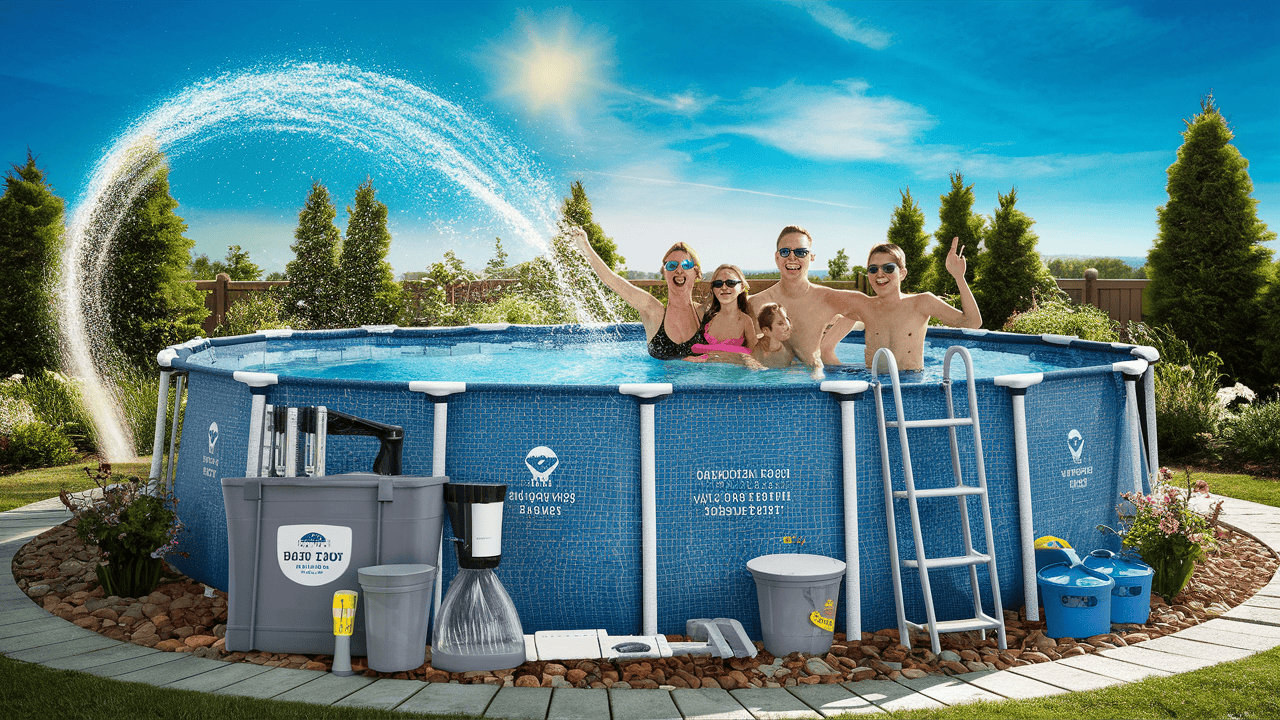Having a pool in your backyard is a dream for many homeowners. It promises endless summer fun, a quick cool-off on hot days, and a great way to host friends and family. However, in-ground pools can be costly and time-consuming to install. This is where above-ground pools come in as a popular and more budget-friendly alternative. If you’re considering installing an above-ground pool, this guide will walk you through everything you need to know.
Best Above Ground Pool Kits
What to Look for When Shopping for an Above-Ground Pool
Material: Above-ground pools primarily come in steel, resin, or hybrid options. Steel pools are strong and durable but prone to rust. Resin pools are resistant to rust and corrosion, making them a good choice in humid climates. Hybrid pools combine both, offering durability and resistance where needed.
Size and Shape: Determine the size and shape of the pool based on your yard’s layout and your intended use. Common shapes include round, oval, and rectangular. Round pools are easier to install and generally more budget-friendly, while oval and rectangular pools offer more swimming space and versatility.
Ease of Installation: Some kits are designed for easy DIY installation, while others may require professional help. Check the product details for installation complexity and whether they include step-by-step instructions, videos, or customer support.
Liner Quality: The liner is another essential component, as it retains the water. Look for a high-quality, thick liner that is resistant to UV rays and punctures. Multi-layered liners last longer and provide more protection against the elements.
Filtration System: A good filtration system keeps the water clean and safe. Sand, cartridge, and Diatomaceous Earth (DE) filters are common choices. Research which option suits your maintenance preference and water clarity needs.
Accessories and Warranties: Look for kits that come with necessary accessories like ladders, skimmers, vacuums, and covers. Additionally, check the warranty details as a good warranty can save you potential costs and give you peace of mind.
How Much Should an Above-Ground Pool Cost?
The cost of an above-ground pool can vary significantly based on several factors:
Size and Shape: Naturally, larger and more complex shapes (like oval or rectangular) will be more expensive. For example, small round pools may start as low as $500, while large custom-shaped pools can cost several thousand dollars.
Material: Steel, resin, and hybrid pools all come with different price points. Steel pools might start around the $1,000 to 1$,500, and hybrids can go upwards of $2,000.
Filtration System: Costs can also vary based on the filtration system you choose. Basic sand filters are generally the most affordable, while DE filters are the most expensive due to their effectiveness.
Installation Costs: If you opt for professional installation, expect to add a significant amount to your budget. Installer rates can vary based on your location and the complexity of the pool.
Additional Features: Features like heating systems, custom decks, lighting, and automated cleaning systems will add to the overall cost.
What To Know Before Buying Above-Ground Pools
Investing in an above-ground pool is a significant decision, and there are several aspects you need to think about before making a purchase. Here’s a recap and some additional key points to consider:
Durability and Maintenance: Consider the longevity and upkeep of different pool materials. Stainless steel pools, while durable, can require treating against rust, whereas resin pools are virtually maintenance-free regarding rust issues. Understand the level of maintenance your chosen pool will require throughout the year.
Budget: Have a clear budget in mind. This should include the initial cost of the pool, installation (if not DIY), and ongoing maintenance. Remember to factor in accessories, chemical treatments, and possible utility cost increases for running the pump and heater.
Climate and Weather Conditions: The climate in your area can affect your pool choice. For instance, a resin pool may be better suited to areas with high humidity or salty air due to its corrosion resistance. Similarly, steel pools might be more advantageous in colder climates due to their robustness.
Usage: Determine how you plan to use your pool. Will it be for leisure, exercise, or entertaining guests? Your intended use will influence the size, shape, and depth of the pool you need.
What Should You Look for in the Size and Shape of Your Above-Ground Pool?
The size and shape of your above-ground pool will significantly impact your overall satisfaction, as well as how well the pool fits into your backyard and lifestyle.
Space Availability: Measure your available space accurately. Your pool needs to fit comfortably without overwhelming your yard. Remember to leave extra space for poolside accessories and safety measures like fencing or decking.
Shapes – Benefits and Considerations:
Round Pools: These are the most common and generally the easiest to install. They offer more swimming space per square foot and have fewer structural challenges.
Oval Pools: These provide a longer swimming area, which is beneficial for lap swimming or games. However, they can be more complex to install and may require additional support.
Rectangular Pools: Ideal for swimming laps and aesthetically pleasing if integrating with a contemporary yard design. Their straightforward shape also makes covering and fencing more straightforward but could require more space.
Lifestyle Needs: A smaller pool may suffice if you’re looking for a pool to cool off quietly. For families or avid swimmers, a larger, oval, or rectangular pool might be more apt for accommodating multiple swimmers and activities.
What Should You Look for in a Pool’s Depth?
The depth of your pool is another crucial factor that affects safety, usability, and comfort.
User Demographics:
Children and Pets: A shallower pool (48 inches or less) is safer for households with small children or pets.
Adults and Teenagers: Standard depths for adult usage range between 48 to 52 inches. Deeper pools can provide a more immersive swimming experience and accommodate more vigorous activities.
Purpose of the Pool:
Recreational Use: For general play and relaxation, a mid-depth pool (around 52 inches) is suitable.
Exercise: Those intending to use the pool for exercise, swimming laps, or diving might prefer deeper options (up to 54 inches). Check the local regulations for minimum required depth for diving.
Adjustability and Features: Some pools offer adjustable depths or sloping bottoms. While rare in above-ground pools, they can provide varied experiences and accommodate different activities within the same pool.
What Are the Frame Types of Above-Ground Pools?
Understanding the types of frames available can help you determine the best pool for your needs regarding durability, aesthetics, and ease of installation.
Steel Frames:
Durability: Steel frames are robust and can support heavier loads and larger pools. They are an excellent choice for those who plan on keeping their pool for many years.
Maintenance: Steel can be prone to rust, so it typically requires some form of rust-resistant treatment or maintenance over time.
Cost: Generally more affordable compared to resin or hybrid frames, making them a budget-friendly choice.
Resin Frames:
Rust and Corrosion Resistance: Resin frames are impervious to rust and corrosion, making them ideal for humid or coastal climates.
Aesthetic Versatility: Resin can come in a variety of styles and finishes, often resembling wood or stone, for enhanced aesthetics.
Heat Resistance: They remain cool to the touch under direct sunlight, increasing comfort when getting in and out of the pool.
Hybrid Frames:
Combining Advantages: Hybrid frames leverage both steel and resin parts, combining the strength of steel with the
Do Above-Ground Pools Include Accessories?
When purchasing an above-ground pool kit, it’s important to consider the accessories included, as they can greatly enhance your swimming experience and ease of maintenance. Some accessories are typically included in the kit, while others may need to be purchased separately.
Included Accessories:
Pump and Filter System: Most above-ground pool kits come with a basic pump and filtration system to keep the water clean. Depending on the brand and model, you might get either a sand, cartridge, or DE (Diatomaceous Earth) filter.
Ladders or Steps: Almost all kits include a ladder or steps for easy entry and exit. Be sure to check the stability and weight capacity of the ladder.
Pool Skimmer: A skimmer helps remove debris like leaves and bugs from the pool’s surface and is often part of the kit.
Pool Liner: A durable, high-quality liner is usually included. It’s essential for retaining the pool water and adding a layer of protection.
Optional but Useful Accessories:
Covers: Pool covers come in various types including solar covers (to retain heat), winter covers (for offseason protection), and safety covers (to prevent accidents). While they might not be included in every kit, investing in the right cover can extend the lifespan of your pool and save on maintenance costs.
Maintenance Equipment: This includes items like vacuum heads, telescopic poles, brushes, and testing kits to ensure your pool’s water quality remains safe.
Heaters: For those in cooler climates, a pool heater can extend your swimming season. Both electric and solar heaters are available.
Lighting: Submersible LED lights or solar lights around the pool can enhance evening swims and provide an ambience for nighttime gatherings.
Fencing and Alarms: Additional safety features such as fencing, pool alarms, and safety nets are worth considering, especially if you have young children or pets.
What’s the Assembly Like for Above-Ground Pools?
The assembly process for above-ground pools varies depending on the pool’s size, shape, and the complexity of the frame. Here’s a general overview of what you can expect:
Preparation:
Ground Leveling: Ensure the ground where you plan to install the pool is level. This might involve removing grass, leveling the soil, and adding a base layer such as sand or a pool pad for added stability.
Permits and Inspections: Confirm that you have all necessary permits and that any inspections required by local authorities are completed.
Setup Steps:
Frame Assembly: Start by laying out all parts and following the manufacturer’s instructions. Assembling the frame usually involves connecting steel or resin segments to form the pool’s structure.
Liner Installation: Spread the liner across the inside of the frame, making sure it is evenly distributed and free of wrinkles. Smooth out any air pockets and secure the liner to the top edge of the frame.
Wall Assembly: Attach the pool walls to the frame. This can be the most labor-intensive part and may require additional hands to hold the walls in place while securing them.
Filling with Water: Begin filling the pool with water, keeping an eye on the liner to ensure it remains properly positioned. Start slowly, allowing the water to weigh down the liner evenly.
Installing the Pump and Filter: Attach the pump and filtration system according to the instructions. This involves connecting hoses to the pool’s skimmer and return jets.
Final Checks and Adjustments: Once the pool is full, check for any leaks or areas that need tightening. Ensure all equipment is securely in place and functioning correctly.
Time Commitment and Help:
DIY vs. Professional Installation: Smaller, round pools can often be installed over a weekend by two to three people. Larger or oval pools might require professional assistance to ensure everything is set up correctly and safely.
Tools Needed: Basic tools like a screwdriver set, a rubber mallet, and a level are typically required. Check the manufacturer’s guidelines for any specific tools.
Instruction Manuals and Support:
Written Guides: Most pool kits come with detailed instruction manuals. Make sure to read through these before starting the installation.
Video Tutorials: Many manufacturers provide video guides that can be incredibly helpful, providing a visual step-by-step of the installation process.
Customer Support: Don’t hesitate to contact the manufacturer’s customer support if you encounter any issues or have questions during the assembly process.
Frequently Asked Questions About Above-Ground Pools
Investing in an above-ground pool is a significant decision, and it’s natural to have questions. Here are some of the most frequently asked questions to help you make an informed choice.
How Long Do Above-Ground Pools Last?
Durability Factors: The lifespan of an above-ground pool depends on its material, maintenance, and environmental exposure. Steel pools can last between 10-15 years with proper care, while resin and hybrid pools can last upwards of 20 years.
Maintenance Practices: Regular maintenance like cleaning, checking the pH balance, and repairing any damages promptly can extend the life of your pool.
Can Above-Ground Pools Be Heated?
Heating Options: Yes, above-ground pools can be heated using various methods such as electric heaters, gas heaters, solar covers, and solar panels. Each option has its own benefits and cost considerations.
Energy Efficiency: Solar heating options are typically more energy-efficient but may depend on your local climate.
Are Above-Ground Pools Easy to Repair?
Common Repairs: Common issues like liner tears, pump failures, or filter problems are generally easy to fix with the right tools and parts. Many manufacturers sell replacement parts and provide repair guides.
Professional Help: For significant structural issues, seeking professional help might be necessary to ensure the pool is safe to use.
How Much Water Is Needed to Fill an Above-Ground Pool?
Volume Calculation: The amount of water required depends on the pool’s size and shape. For example, a standard round pool with a 24-foot diameter and 52-inch walls requires approximately 13,500 gallons of water.
Water Source: Consider the logistics of filling the pool, whether using a garden hose, delivery service, or your municipal water supply.
Do I Have to Disassemble My Above-Ground Pool During the Winter?
Disassembling your above-ground pool for winter isn’t always necessary, but it depends on your climate and pool type:
Winterizing the Pool:
Cold Climates: In regions with freezing temperatures, it’s important to winterize your pool to protect it from ice damage. This involves lowering the water level, adding winter chemicals, and covering the pool with a sturdy winter cover.
Milder Climates: In milder climates, simply covering the pool and maintaining proper chemical balance might be sufficient.
Benefits of Keeping It Assembled:
Saves Time: Keeping the pool assembled can save you the effort and time required to disassemble and reassemble it each season.
Durability: Constant assembling and disassembling might weaken the structural integrity of the pool over time.
Steps for Winterizing:
Clean the Pool: Thoroughly clean the pool of debris and balance the water’s pH, alkalinity, and calcium hardness.
Lower the Water Level: Drain water down to about 4-6 inches below the skimmer or specific instructions from your pool manufacturer.
Remove Accessories: Remove all accessories like ladders, skimmers, and hoses, and store them indoors.
Add Winter Chemicals: Add appropriate chemicals to prevent algae growth and maintain water quality.
Cover the Pool: Use a winter cover to protect the pool from debris and harsh weather.














